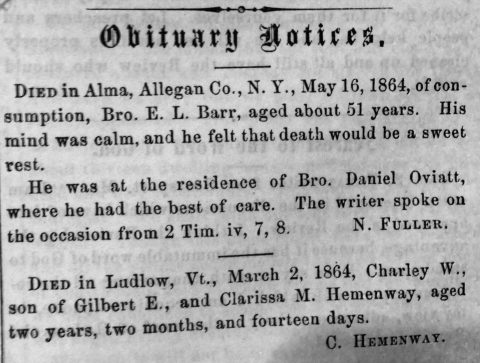
Now, imagine a Black minister drawing hundreds of interested white people to a meeting. Imagine him building up and organizing churches in mostly white communities. Imagine him chairing regional general conferences of mostly white believers. Imagine that minister ordaining white people to the gospel ministry. This egalitarian spirit was largely unimaginable, even in the North. And yet, it was true. But it is part of a largely forgotten story.
Eri L. Barr (1814–1864) had been a Millerite and he believed in the soon second coming of Jesus Christ. Like others, he was disappointed when Jesus did not return on Oct. 22, 1844. He remained true to his Adventist conviction for several years, but it was not until the spring of 1852 that he became a Sabbatarian Adventist. Soon after embracing the Sabbath, he became an itinerant minister. And for the next eight years, he worked in “dozens of towns and settlements in Vermont, Maine, New Hampshire, Massachusetts, Connecticut, and Pennsylvania, with brief forays into Canada and Rhode Island. He would partner with eight Sabbatarian ministers, including Frederick Wheeler, Joseph Bates, and John N. Andrews,” all pioneers of the cause.
Had it not been for census records and vital records, we would not have known the complexion of his skin because, contrary to the customs of the time, Adventists did not care about mentioning the skin color of non-whites. They perceived them as equals.

In 1855, Bates and Barr, a white man in his 60s and a black man in his 30s, worked well in tandem and conducted 12 to 20 meetings preaching unfamiliar doctrines throughout New England. In Canaan, Maine, for example, a crowd of 500 people came out to see them at a tent meeting, with baptisms resulting. Besides organizing and chairing numerous general conferences --then held as weekend meetings for believers in the region-- Barr also ordained ministers to the gospel ministry, most notably A. C. Bourdeau, the French-speaking pastor-evangelist and pioneer of the Adventist cause in Vermont, Quebec, and parts of Europe. That he was granted the authority to ordain illustrates not only his standing among Sabbatarian Adventists, but also their racial egalitarianism.
The pace of Barr’s itinerant ministry took a toll on his health. He battled tuberculosis during the last three years of his life, and he succumbed to the disease a few days before his 50th birthday, cutting short his impact and legacy. His biographer, Benjamin Baker, estimates that during his eight-year ministry, Barr converted between 150 and 300 people to Sabbatarian Adventism. Considering that there were only 2,000 to 3,000 Sabbatarian Adventists in the late 1850s, it becomes obvious that Barr had a tremendous influence in the growth of the young Sabbath-keeping movement.
Denis Kaiser is an associate professor of church history at the Seventh-day Adventist Theological Seminary at Andrews University.